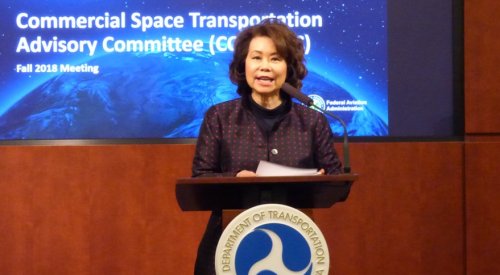WASHINGTON — Federal Aviation Administration officials said Oct. 31 that they’re on schedule to release a draft rule reforming commercial launch regulations, although some in industry are concerned that the work is going too quickly.
At a meeting of the FAA’s Commercial Space Transportation Advisory Committee (COMSTAC) here, agency officials, as well as Secretary of Transportation Elaine Chao, said work on the regulatory reforms, mandated by Space Policy Directive 2 in May, was on schedule.
“This proposal has the potential to be a real game changer and also make American launching sites, and well as American launchers, more attractive to the global marketplace,” Chao said in brief remarks at the meeting.
The ongoing reform process is intended to streamline existing regulations. Among the goals of the process is to allow the use of performance-based approaches, giving companies the ability to choose their preferred approach to meeting safety requirements rather than prescribing a specific technical solution. The reforms would also allow launch licenses for the same vehicle to be valid at multiple sites, rather than the current requirement of a separate license for each launch site used by that vehicle.
The policy directive set a goal of producing a draft rule, in the form of a notice of proposed rulemaking (NPRM), by next February. “The target and intent — and we view it not as anything less than an obligation to follow the requirements under SPD-2 — is to publish an NPRM on Feb. 1,” said Dorothy Reimold, acting deputy associate administrator for commercial space transportation at the FAA.
That schedule is far faster than a typical rulemaking process, which can take several years. “We’re moving at a rocket pace. We’re going as fast as we possibly can,” said Kelvin Coleman, acting associate administrator for commercial space transportation at FAA, who runs its Office of Commercial Space Transportation, or AST. “It’s humbling, challenging and exciting, also, to be asked to do so much at a breakneck pace, and the Department of Transportation, the FAA and AST will not disappoint.”
That effort, he said, remains on schedule. “We’re on track, and we’re working hard to stay on track, with only three very short months to go before we publish the proposed rule,” he said.
Some COMSTAC members, including representatives of commercial launch providers, said they were disappointed in the lack of details about what the FAA was actually developing in the proposed rule. “I want to really register a strong concern with how the FAA is approaching the upcoming NPRM,” said Brett Alexander, director of business development for Blue Origin, during the meeting.
He cited a “lack of dialogue, insight, transparency and engagement” by the agency with industry, in particular COMSTAC, whose purpose is to provide advice to the FAA on commercial space issues. “I think, frankly, after repeated calls for that engagement, it is of concern to me, and to a number of other members, that the FAA has decided not to do that.”
Other committee members noted that a separate group, the Advisory Committee for Commercial Remote Sensing, was able to see a draft rule developed by the Commerce Department on licensing reform for commercial remote sensing systems in advance of its public release, but were not allowed to disseminate it outside of the group.
Reimold said that the tight schedule for developing the proposed rule was the reason for the limited opportunity for input. The FAA earlier this year established what is known by the agency as an Aviation Rulemaking Committee (ARC) to provide recommendations on how to revise the regulations. That committee has since made “repeated offers,” she said, to stay involved in the process, but the FAA has been unable to accommodate them.
“Frankly, as we’ve said many times to individuals and to groups, time has not been on our side,” she said. “We have not been able to bring the ARC back together to have the kind of venue that I think was being sought, not for lack of wanting to but simply because time has not allowed us to do that.”
Industry, and the rest of the public, will have an opportunity to review and comment on the draft rule when it is published next February. Reimold said she didn’t know how long that public comment period would last.
“We understand people want to see what we’re doing. We get it, and we’re not ignoring that,” Coleman said, emphasizing the FAA’s desire to stay on schedule. “I want to almost say, ‘trust us.’ But we’re doing the best job that we can. I’m going to ask for that favor: just trust us, we’ll get you there in three very short months from now.”
- SN Military.Space | Who’s who in the national security space workforce • Doubts raised about cost of Space Force • U.S., Brazil to share space data
- SN Military.Space | Space Force a political football • The next big thing in space missile defense • How to make satellites ‘defendable’
- SN Military.Space | Space reorganization: Reform fatigue already? • SMD Symposium underway in Huntsville • DARPA soon to announce Blackjack winners
- Why Sierra Nevada’s owners are betting big on Dream Chaser
- SpaceX takes top honors in SpaceNews Awards for Excellence & Innovation
Share with your friends

(0) Comments
This article comments are currently no :(